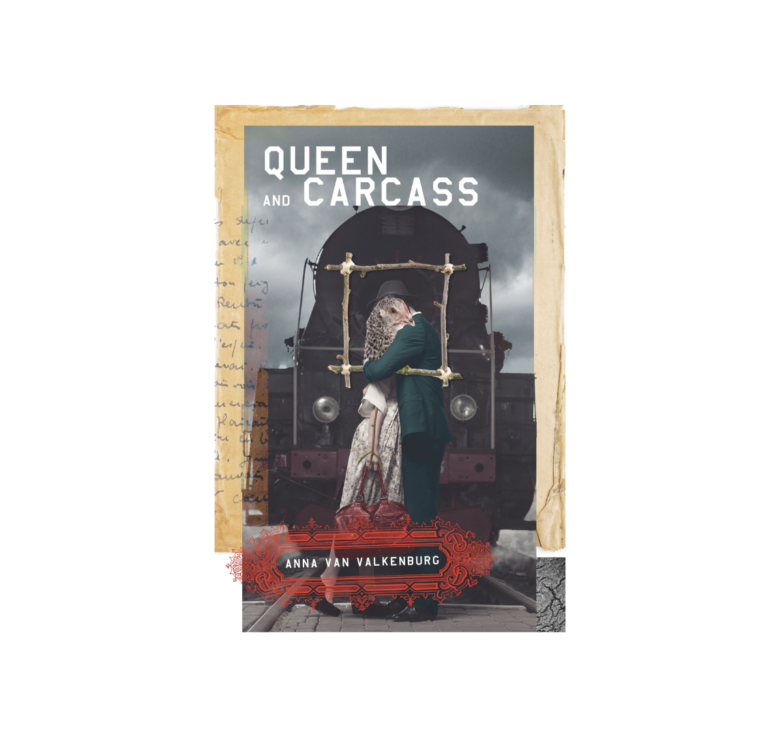Review of Queen and Carcass
Anvil Press. 2020. 96 pages.
A parade of unsettling paradoxes are at the strange and staggering heart of Anna Van Valkenburg’s debut poetry collection, Queen and Carcass. From the first poem, we’re introduced to the surrealist cacophony of Van Valkenburg’s world and its many skies and shadows. “Melodies” captures a woman, Aunt Krystyna, “defeathering a white hen / in her courtyard, in the shadow / of a heap of clouds.”
The thematic interplay of beauty and the grotesque is one of the driving juxtapositions of the collection. The chicken in “Melodies” is alive and peacefully receptive to the violence being enacted on it, its “stick feet work as a metronome / going up and down, / up, down.”
Another paradox that persists throughout Van Valkenburg’s poems is that of shadow and light. This is a much-loved theme of poets, so if one is going to use it, one has to reinvent perception. Through her singular surrealist lens, Van Valkenburg does just this. In fact, reading Van Valkenburg’s poems, I didn’t meet a shadow I didn’t like.
A vivid example in “A Portrait of Serving Girls as Nightingales”: “the cows have shed their shadows / under the juniper and slither / into the pastures; / what was dark turns darker / in the sun.” Van Valkenburg’s surrealist slant includes a sickening and stunning rearrangement of the natural world. The shadows don’t slither; the cows do.
Then there is the recurring presence of the Rusalka: a mermaid-like entity of Slavic origin who is sometimes benevolent, sometimes malicious, and always charged with a dark and baffling irresistibility. In “Rusalka Stained”, the Rusalka coos to her lover with a disturbing intimacy that makes the poem more surreal still. Valkenburg masterfully brings together disparate images of “Alice-blue breasts”, “boiled bones in big pots” and praying “in temples that felt good because they didn’t feel right.”
In “Oath of Modern Day Rusalka”, the Rusalka is an uncompromising force that defies the laws of nature. She says: “I don’t have to be physical. / I don’t have to have colour or structure / in the soft of a palm; / I can be air / that lives inside one lung / then pushes into another. / I will be the pushing.”
What makes Van Valkenburg’s writing so striking is that it warps the world. Her poems describe a world we know, but it’s convex; fish-eyed. Her writing is comparable to other contemporary surrealist poets who work this warp. Jason Heroux comes immediately to mind. Heroux has been described as an everyday surrealist: his stage is the now and not-quite-here. The difference between Van Valkenburg and Heroux is that much of Van Valkenburg’s work feels as if it is being written from another time, not just another place.
With Queen and Carcass, Van Valkenburg manages to hold her own amongst fellow surrealist poets, while creating a whole new space. It’s a space that’s replete with tender, powerful, and unapologetic contradictions. It’s a space that’s unmistakably inhabited by a woman.
Queen and Carcass is a collection that builds, starting like a quiet rustling of wind through leaves then building to a delirious crescendo in the final section. Gentle surrealism gives way to a rapt and ruptured world where contradiction is Queen. Throughout the collection, we’re mesmerized by the words and worlds Van Valkenburg weaves around us, her masterful warp and weft enveloping us in the threads of her gorgeous and grotesque tapestry.
Hollay Ghadery is a writer living in small-town Ontario. She has her MFA in Creative Writing from the University of Guelph. Her fiction, non-fiction, poetry, and reviews have been published in various literary journals, including The Malahat Review, Room, Grain, CAROUSEL, and The Fiddlehead. Her upcoming book of non-fiction, FUSE, is coming out with Guernica Editions’ MiroLand imprint in Spring 2021.

